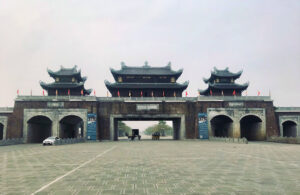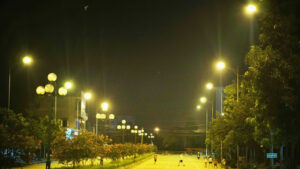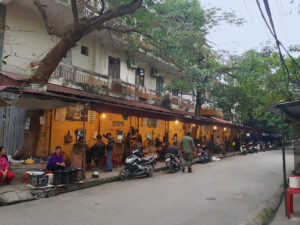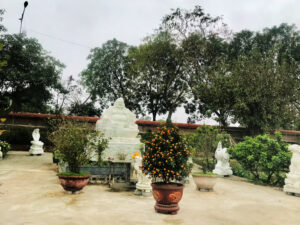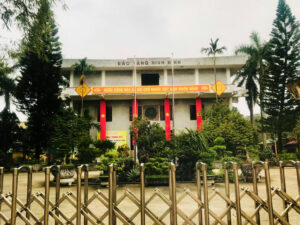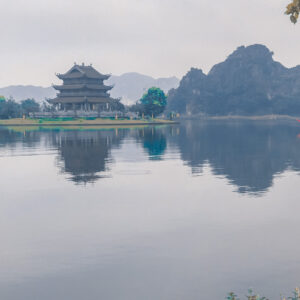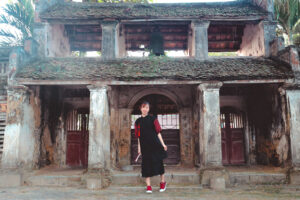Ninh Bình City is on the confluence of three important tributaries of the Red River: the Van, the Hoang Long and the Day Rivers. These three waterways have provided important trade routes since time immemorial and a big part of the reason the city grew to such an important transport hub.
A modern and dynamic metropolis with a population of 200,000, Ninh Binh City is located 93 kilometers south of Hanoi. The capital of the Province of the same name, TP Ninh Binh is the current administrative center for this famous region. Cherished as “a sacred place with extraordinary people”, Ninh Binh has always been at the forefront of Vietnam’s long and illustrious past.
With its adjacent ancient buildings and stunning scenery, Ninh Binh City now services the booming tourist industry that has sprung up around the Tam Coc –Trang An – Van Long historical and environmental protection areas. Ninh Binh City also provides a diverse range of health, government, shopping and accommodation services. As the regional transport hub, it is also the place where most travelers will first arrive.
Transportation Hub
For many it is the “jumping off” point for the many splendors of the surrounding areas. In 2015, authorities relocated and upgraded the old railway station from 4 tracks to 11 to facilitate travelers. As it is on the main Hanoi-Saigon line, there are daily connections to many of the regional cities in Vietnam.Although it lies a little way out of the town center on Ngo Gia Tu Street in Nam Binh ward, taxis and Grab rides frequently service the area, especially at train arrival times.
The old station was near the Ninh Bình bridge across the Đáy River and had a significant role during the first Indochina War. Facilitating the transfer of soldiers, foods and weapons became an important contribution to the struggle against the French armed forces.
Unfortunately, the French also noticed this and bombed and targeted it regularly. In typical Vietnamese sang froid, locals have since renovated it as a restaurant, which visitors can find at 1 Hoang Hoa Tham Road in Than ward.
A Modern Town
It goes without saying that Ninh Binh City has been prominent in the various rebellions and wars that have swept over Vietnam for millennium. Unfortunately, fierce fighting often destroyed many of the historical buildings in the town center. To new visitors, it often represents a fairly bland urban center, a stark contrast to the many ancient temples, buildings, farms and forests that surround it.
On the plus side, Ninh Binh province lacks a lot of the heavy industries and traffic of its neighboring cities. This gives the town a relatively modern and progressive atmosphere, with a laid back attitude that is in tune with the stunning landscape of the province.
Ninh Binh City, like the province itself, spreads out over some 48.37 km² and so far lacks the high-density housing that typifies large Vietnamese cities.However, this can make exploring without some form of private transport problematic and/or expensive. The good news is that the city is part of the north-east plains area of Ninh Binh province and is so relatively flat and bicycles are a popular mode of transport. Here’s a word of warning for anyone unfamiliar with the free-for-all that is Vietnamese traffic: exercise some caution!
The city center clusters around Luong Van Tuy Street, Luong Van Thang Street, and Truong Dinh Street, hosting a variety of restaurants, retail outlets, clothing shops, and hotels. As it lacks many Western-style eateries and English fluency is still rising, Google Maps and Translator apps will serve you well.
A River Town
Both the Van and Day Rivers flow through the city and are important for flood mitigation and transport. They also provide an attractive and calming counterpoint to the urban landscape. Bridges connecting the two sides of the city are common, with the largest being the two steel bridges of Non Nuoc Bo and Ninh Binh Bridge. On the river, there are two major shipping centers at Ninh Phuc port and Ninh Binh port which form a significant part of the cities livelihood
As a major regional trading center, there are several market, with the most notable being the Cho Rong (Dragon Market) at 71 Van Giang Street, around 2km from the Ninh Binh city center. A sprawling Asian bazaar, you can source anything from a plate of fresh cooked Mountain Goat to a set of steel capped boots. But be warned, this is hot, dusty local market, and they do not specifically target tourists. Caveat emptor is the rule of law here – check quality and bargain hard.
Having said that and for those short of time, many of the famed local handicrafts such as Kim Son sedge goods, Phuc Loc wood carvings and Ninh Phuc flowers are conveniently located under one roof. There is also a food court that along with traditional Vietnamese foods serves such local delicacies such as Muong’s pig, eel, Van Long small shrimp, Kim Son rice wine and Ninh Binh rice crust
Logistics
Heavily influenced by Red River Delta popular culture and its near neighbor of Hanoi, Ninh Binh City borders with Nam Dinh Province to the west, Hoa Lu district to the west and Yen Khanh district to the south. Major highways and roads heading in all directions connect the city well, alongside river and rail transport for the more adventurous.
As such, there are a multitude of options for road travel to just about anywhere in Vietnam. “Limousine” coaches which host between 6-8 guests in air-conditioned comfort to nearby destinations such as Hanoi and Halong Bay abound and will often include a door to door service from your current hotel to your intended destination. Private taxi or charter hires are common if you are in a group and Uber-like carriers such as Grab and GoViet are available for shorter journeys.
For those on a budget or for longer trips, the main Bus Terminal is at 207 Lê Đại Hành street in the Thanh Bình area of town. There are a variety of bus lines and locals can advise which are the best but it is always good to book in advance. If you go to the terminal the day before, you could do worse than a side visit to Non Nuớc Pagoda and the nearby Ninh Binh Museum (Bao Tang) on the opposite side of Thuy Son Park.
Non Nuớc Pagoda
Non Nước Pagoda in Ninh Binh is an ancient Buddhist temple located at the foot of the Non Nuoc “mountain” alongside the Day River. Local people originally constructed it during the Ly Dynasty (1009–1225). War and neglect destroyed it, but people rebuilt it during the Tran Dynasty (1226–1400). They have destroyed and rebuilt the pagoda many times since, but authorities now recognize it as a national historical and cultural relic for its stunning location, history, and architecture.
Relatively unknown by European tourists, it is a huge draw card for thousands of domestic tourists who visit the region annually. Also known as Duc Thuy Son Pagoda, the temple is constructed entirely with local stone and features a spectacular garden area full of exotic statues and well tended gardens. A truly remarkable, serene and tranquil refuge from the surrounding city.
Non Nuoc is part of Thuy Son Park, an 8 hectare area that has been put aside as part of the “green lungs” project of Ninh Binh City. Situated on the banks of the Day River, Thuy Son Park is a popular exercise and recreational spot for locals, containing a swimming pool and a small zoo. Crisscrossed with paths and walkways, the park provides a peaceful venue for office workers, students and families to keep fit and a great place to meet people, especially in the early morning and late afternoons.
Bảo Tang Ninh Binh
To the south of Thuy Son Park is Ninh Binh Museum (Bảo Tang Ninh Binh), a must-see for any visitors with an interest in the history and culture of the Province. Spread out over an area of some 1.2km² with an exhibition space of around 500m², the Museum building was designed to emulate a lotus emerging from green mountains and blue water. Inaugurated in 1995 during the 50th anniversary of Ho Chi Minh’s Declaration of Independence of 1945, all four sides of the 3 storey building are decorated with bronze “DongSon” drum motifs, fitting symbols of Vietnamese civilization and longevity.
The Museum documents the province’s history before, during, and after the August Revolution (1945) with weaponry, busts and maps from that turbulent period. There are also displays of numerous historical items and artefacts from local archaeological digs, recreating the lives of the ancient Ninh Binh inhabitants. There are also displays of ceramics, precious artifacts, pottery, art and exhibitions showcasing all of Vietnam past dynasties to the present Republic. A great introduction to the diversity, industriousness and traditions of Ninh Binh Province..
Ngoc My Nhan
Like Non Nuoc mountain, Ngoc My Nhan mountain is located on the banks Day river and is one of the “Four great mountains” of Ninh Binh city. In the eastern part of the city, Ngoc My Nhan is said to have three “peaks” that resemble a bird. The tallest outcrop is the head while the two smaller ones point outward “like a bird’s wings”. To one side is the Tien Son Cave which is set aside for the worship of the spirits of the mountain “petrified” into stalactites,
Further up the mountain, you will find the Thanh Ca temple, also known as Hung Thien Tran Vu Temple. Worshipers reserve this temple for Thien Ton, whom they consider a “god” and saint of the eastern region of Hoa Lu capital. Overlooking Canh Dieu lake and shaded by perennial green trees, builders originally constructed the temple over a thousand years ago. Wars with the French and Americans destroyed it, but locals rebuilt it again from 1996 to 2001.
Thanh Ca Pagoda
Thanh Ca Pagoda has no caves or stalactites but 2 temples at the foot of the mountain. It is famous in Vietnamese culture and often known as Kite mountain. According to legend, a Chinese Lord named Cao Bien ( Gao Pian) once possessed magical powers. This evil Lord wished to rain down a curse to destroy the legend of the “Land of Talented People”. To do so he built a massive kite and flew to great height so as to properly spread the intended curse. However, local people fatally shot the Kite, causing it to fall to the ground and break the wings that now form the shape of the mountain.
Each of the “Four Mountains of Ninh Binh City” have tales of history, mystery and mythology that tourists can explore, such as Núi Kì Lân (Unicorn mountain- a creature symbol of Vietnamese mythical culture), Núi Non-Nước (Non-Nuoc Mountain), Núi Cánh Diều ( Kite Mountain), and Núi Chàng Lớ aka Núi Cá Voi (Whale Mountain).
A Plethora of Pagodas
Scholars link A Nau Pagoda to one of Vietnam’s most enlightened periods during the Tran Dynasty (1226–1400). A national historical monument, Dau Long Pagoda is one of Vietnam’s oldest pagodas. The Golden Pagoda, adjacent to Chàng Lớ (Whale) Mountain, captivates every visitor with its lyrical and dreamlike beauty , painting a picture of “faraway illusions that cannot be touched.” Visitors poetically describe Hung Long Pagoda’s venerable beauty and immaculate gate as “dandelion blossoms flowing in the breeze and gently dropping on the quiet lake surface.”
We have only listed a few of Ninh Binh City’s many attractions. We plan to develop this section as we go along but hopefully we been able to make your visit to Ninh Binh City a little more interesting.
For the various health, government, police and travel issues that may crop up, Ninh Binh City is the center for many hospitals, clinics, Government offices and so on. We have put together a directory listing some of the services but for more serious concerns, Hanoi is only an hour or two away by luxury van. In the meantime, as always, travel well.

